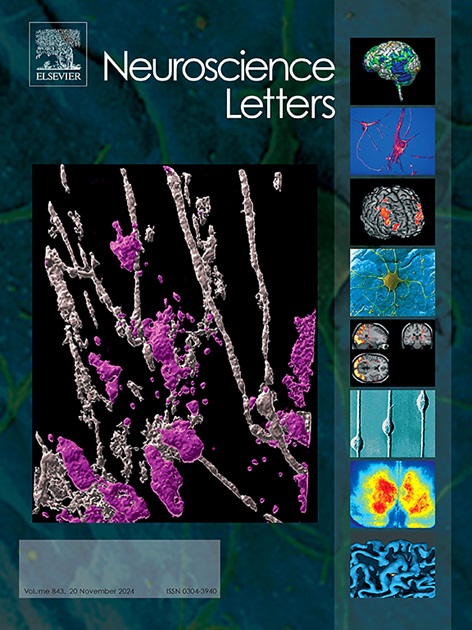Neurochemical alterations in monoaminergic systems induced by excessive sucrose consumption from the juvenile period to adolescence in mice
IF 2.5
4区 医学
Q3 NEUROSCIENCES
引用次数: 0
Abstract
Postweaning to early adulthood is a critical period for neural maturation, with dopamine (DA) and serotonin (5-HT) systems undergoing significant changes. Excessive sucrose (SUC) intake during this period is associated with metabolic and neuropsychiatric disorders; however, its effects on neurodevelopment remain unclear, especially in comparison to noncaloric sweeteners like saccharin (SAC). Therefore, we aimed to investigate the impact of chronic SUC and SAC consumption from postweaning to early adulthood on DA and 5-HT metabolism in the mesocorticolimbic system. Male mice of the Institute of Cancer Research strain received 20 % SUC or 0.2 % SAC ad libitum from postnatal days 21–56. Response to amphetamine (AMP) treatment was determined using the open-field test. The levels of DA, 5-HT, and their metabolites in the mesocorticolimbic system were assessed using high-performance liquid chromatography. Unlike SAC, SUC increased locomotor activity and attenuated the AMP response. SUC and SAC reduced DA levels in the prefrontal cortex (PFC). SUC altered DA turnover in the dorsal striatum and hippocampus, whereas SAC affected the PFC. Differences in the 5-HT/DA ratio further highlighted distinct neurobiological effects. Excessive SUC and SAC consumption during the critical developmental window induces region-specific alterations in DA and 5-HT metabolism, suggesting distinct neural effects of caloric vs. noncaloric sweeteners. These findings emphasize the need for further research on their long-term neurodevelopmental consequences.
小鼠从幼年期到青春期过量蔗糖摄入引起的单胺能系统的神经化学改变。
断奶后到成年早期是神经成熟的关键时期,多巴胺(DA)和血清素(5-HT)系统发生重大变化。在此期间过量摄入蔗糖(SUC)与代谢和神经精神疾病有关;然而,它对神经发育的影响尚不清楚,特别是与糖精(SAC)等无热量甜味剂相比。因此,我们旨在研究断奶后至成年早期慢性SUC和SAC消耗对中皮质边缘系统DA和5-羟色胺代谢的影响。癌症研究所品系的雄性小鼠在出生后21-56天随意注射20% SUC或0.2% SAC。采用开场试验确定对安非他明(AMP)治疗的反应。采用高效液相色谱法测定中皮质边缘系统中DA、5-羟色胺及其代谢物的水平。与SAC不同,SUC增加了运动活动并减弱了AMP反应。SUC和SAC降低了前额皮质(PFC)的DA水平,而SAC影响了PFC, SUC改变了背纹状体和海马的DA转换。5-HT/DA比值的差异进一步突出了不同的神经生物学效应。在关键的发育窗口期,过量的SUC和SAC摄入会引起DA和5-HT代谢的区域特异性改变,这表明热量甜味剂与无热量甜味剂对神经的影响不同。这些发现强调了对其长期神经发育后果进行进一步研究的必要性。
本文章由计算机程序翻译,如有差异,请以英文原文为准。
求助全文
约1分钟内获得全文
求助全文
来源期刊

Neuroscience Letters
医学-神经科学
CiteScore
5.20
自引率
0.00%
发文量
408
审稿时长
50 days
期刊介绍:
Neuroscience Letters is devoted to the rapid publication of short, high-quality papers of interest to the broad community of neuroscientists. Only papers which will make a significant addition to the literature in the field will be published. Papers in all areas of neuroscience - molecular, cellular, developmental, systems, behavioral and cognitive, as well as computational - will be considered for publication. Submission of laboratory investigations that shed light on disease mechanisms is encouraged. Special Issues, edited by Guest Editors to cover new and rapidly-moving areas, will include invited mini-reviews. Occasional mini-reviews in especially timely areas will be considered for publication, without invitation, outside of Special Issues; these un-solicited mini-reviews can be submitted without invitation but must be of very high quality. Clinical studies will also be published if they provide new information about organization or actions of the nervous system, or provide new insights into the neurobiology of disease. NSL does not publish case reports.
 求助内容:
求助内容: 应助结果提醒方式:
应助结果提醒方式:


